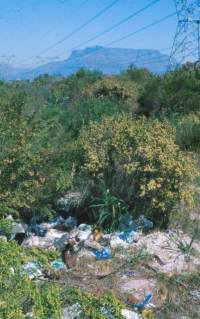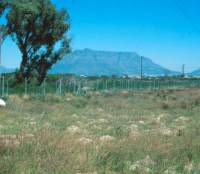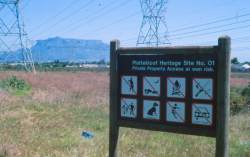Serruria aemula
Serruria aemula Salisb. ex Knight
Family: Proteaceae
Common names: strawberry spiderhead
Introduction
Serruria aemula once occurred in huge stands on the Cape Flats near Cape Town from Milnerton to Rondebosch. Sadly this beautiful species has been reduced by farming and urban development, to a few populations along road reserves and under power lines totalling about 1 000 plants. Unless there is urgent and appropriate field management of the few remaining natural populations, this species will become extinct in the wild within the next few decades.

Description
Description
Serruria aemula forms a sprawling, much-branched shrublet reaching a height of 0.5 m. The leaves are finely dissected and point upward and with its tangled branch structure produce an overall woolly effect. Older plants consolidate their growth into a dense-growing rounded shrub. The plant produces numerous solitary silky (silvery) pink, sweetly scented flowers from July to October. These flowers can cover the entire plant producing a spectacular display in spring and early summer. This species includes a number of different growth forms. The most notable being a densely leaved and flowered variety called 'congesta'. This form has not been seen in nature since the 1980's and is believed to be extinct. Serruria foeniculacea, which occurs at Rondevlei has also been recognized as another form of S. aemula. S. foeniculaceae has a typically lax growth habit by comparison.
Serruria aemula is relatively short-lived and reproduces from seed. Seeds are released within two months of flowering.
Conservation Status
Status

This plant is endangered due to extensive urbanization around Cape Town and resulting destruction and fragmentation of its habitat. Changes to the habitat by alterations in drainage, water pollution, air pollution (acid rain), dumping and lack of a fire management plan, pose serious threats to the remaining communities.
Alien invasion

Encroachment and infestation of natural areas by alien Acacia species has negatively affected natural populations.
Management of alien vegetation under power lines through brush cutting and spraying herbicides, have serious implications for the future of the populations in the area.
The introduction of Argentinian ants poses another threat as they outcompete indigenous ants, which carry the fruits (seeds) underground and so protect the seeds prior to germination. If the fruit is not stored underground it becomes susceptible to predation by rodents.
Climate change
Predictions of climate change in southern Africa could have serious consequences for temperature and rainfall patterns. The predictions are that the effect of climate change on plant communities is not easy to determine for individual species, but the long-term prognosis is not encouraging.

INITIATIVES TOWARDS SURVIVAL
In situ conservation:

The main remaining populations occur under power lines managed by ESKOM. The land has been given National Heritage Site status because there are a number of threatened Cape Flats plants growing on it. An advisory committee comprising representatives from ESKOM, Cape Nature Conservation Board, Kirstenbosch, Botanical Society and professional conservation biologists, is working towards establishing appropriate land management practices to ensure the survival of the remaining populations.
Ex situ conservation:
Plants are being propagated and grown at the Kirstenbosch Botanic Gardens for re-introduction to the damaged areas under the power lines. Plants are also grown for display in the gardens and are available for sale at the Annual Plant Fair in March of each year. Seed will be collected and stored in the Millenium Seed Bank at Wisley. This seed is subjected to low temperatures where it can be kept for long periods. The seed remains the property of the country of origin.
Distribution and habitat
Distribution description
Serrurias grow on the mountains and flats of the southwestern Cape from the Cederberg to near Mossel Bay.
Serruria aemula grows in deep acid sand at low altitudes (20-70 m). It is exposed to wet soils and cool and mild conditions during winter (0-18°C). The warm summer months are normally hot, dry and windy (10-28°C) and the soils can become loose and dry.
The plants survive better if there is a good, closely growing community consisting of a mixture of natural vegetation in a relatively undisturbed state. These plants serve to protect each other and form a natural vegetation cover that keeps the soils cooler and bind the sandy soils.
Derivation of name and historical aspects
History
The genus Serruria belongs to the protea family and was named in honour of J. Serrurier who was Professor of Botany at the University of Utrecht in the early eighteenth century. The specific name aemula means rival presumably referring to its beauty. The common name refers to the old flower heads, which turn bright red and swell as the fruit ripens resembling a strawberry.
Typical examples of plants found in this community are Serruria fasciflora (common pin spiderhead), Diastella proteoides (Flats silkypuff), Leucospermum hypophyllocarpodendron (green-snakestem pincushion), Leucadendron levisanus (Cape Flats conebush), Erica mammosa (ninepin heath), E. ferrea, and restios (Cape reeds).
Ecology
Ecology
The seeds are small, hard-shelled, oval nutlets, covered by a fleshy skin called the elaiosome. The elaiosome secretes a chemical substance that attracts ants and they carry the seed to their underground nests where they consume the elaiosome. The seed remains underground safe from predators such as rodents until conditions are right for them to germinate. Buried fruits will receive their cue to germinate from subtle changes around them after fire has occurred. These include increased changes in day/night soil temperature fluctuations once vegetation cover has been burnt away. Other factors include increased availability of oxygen once the ants abandon the nest and increased pH in the nest. Fire is therefore a necessary element in the life cycle of Serruria aemula. The beneficial effects of fire can, however, have a negative effect if fire occurs too regularly. This will reduce the ability of the plants to produce a viable store of seed for future generations.
Numerous honeybees and small butterflies were seen visiting the flowers. The bees were carrying large pollen sacs on their hind legs. It is assumed that they are the main pollinators.
Growing Serruria aemula
Grow
Serruria aemula is easily reproduced from tip or heel cuttings taken in spring or autumn. Successful rooting depends upon having good propagation houses with mist benches and under-floor heating. Cuttings are rooted in a 50:50 mixture of 6 mm milled pine bark and polystyrene balls. Applying a rooting hormone for semi-hardwood cuttings will stimulate rooting. Rooting takes place from six weeks onwards. Rooted cuttings are removed from the mist benches and hardened off for a few weeks before planting. The hardened-off cuttings are planted out into a potting medium made up for fynbos plants. A suitable mixture consists of a mixture of acid river sand, composted pine bark in equal parts and 205 loam/topsoil by volume.
Seed is collected as it is released from the flower head. Premature removal of seed will result in failure. Seed is sown in late summer or early autumn to harness the positive effects of higher variance between day and night temperatures. Seed exposed to a short period of high temperature followed by rapid cooling in water has been known to germinate very well. The seed should be protected from fungal pathogens by application of a fungicide designed to treat pre- and post-emergence damping off.
Plants should be kept in a well-ventilated and lit area and preferably watered in the morning. Plants that are consistently wet at night will develop fungal infection. They may be fed every week with an organic seaweed-based fertilizer.
Young plants should be planted in autumn or during the cooler months for them to become established before the onset of summer. Plant in full sunlight and ensure that the soil is well drained. Mulching with wood chips or compost will keep the soil cool and help feed the plants.
References
- REBELO, A.G. (Tony). 2000. Proteas of the Cape Peninsula. Protea Atlas Project, National Botanical Institute, Cape Town.
- REBELO, A.G. (Tony). 1995. Sasol proteas. A field guide to the proteas of southern Africa. Fernwood Press, Cape Town.
- VOGTS, M. 1982. South Africa's Proteaceae. Know them and grow them. Struik, Cape Town.
Credits
Anthony Hitchcock and Trevor Adams
Kirstenbosch National Botanical Gardens
November 2002
Plant Attributes:
Plant Type: Shrub
SA Distribution: Western Cape
Soil type: Sandy
Flowering season: Spring, Early Summer, Autumn
PH: Acid
Flower colour: Pink
Aspect: Full Sun
Gardening skill: Average
Special Features:
Horticultural zones







Rate this article
Article well written and informative
Rate this plant
Is this an interesting plant?
Login to add your Comment
Back to topNot registered yet? Click here to register.